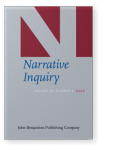Vol. 32:2 (2022) ► pp.393–423
The continuum of identities in immigrant students’ narratives in Greece
Our study draws on the interaction between the micro-level of individual discursive choices and the macro-level of discourses. Having at our disposal narratives by immigrant students in Greece, we highlight the continuum of identities observed. For the investigation of immigrant students’ identity construction in their narratives, we mainly employ an enriched version of Bamberg’s model (1997) on narrative analysis. This model includes the micro-levels of narrative world and narrative interaction in the context of which narrators position themselves towards the discourses of the macro-level – in our data, towards the discourse of Greek national homogenization. We distinguish among three types of identities forming a continuum from legitimization to resistance with in between hybrid stages. Our analysis shows that, despite the catalytic effect of the Greek national homogenizing discourse on the construction of immigrant students’ identities, some students find ways to resist it.
Article outline
- Introduction
- Combining macro- and micro-levels for the investigation of identities
- Macro-level
- The discourse of national homogenization
- The discourse of Greek xenophobic homogenization
- Data and data collection process
- Micro-level
- Narrative, migration and the narratives of our study
- Narrative construction of identities and the goals of the analysis
- Positionings in the micro-level of the narrative world (level 1)
- Positionings in the micro-level of narrative interaction (level 2)
- Overall positionings in the macro-level of discourses (level 3)
- Analysis
- Legitimizing identities
- Narrative world (level 1): Predicates of difficulties and adjustment acts
- Narrative interaction (level 2)
- Overall positioning in the macro-level of national discourse (level 3)
- Hybrid identities: The disclaimer I’m adjusting myself, but…
- Narrative world (level 1) and narrative interaction (level 2): The desire to reconnect with the place of origin and the recollections of racist behaviors in the host country
- Overall positioning in the macro-level of national discourse (level 3)
- Identities of hybrid resistance
- Narrative world (level 1): Predicates of majority racist behaviors
- Narrative interaction (level 2)
- Overall positioning in the macro-level of national discourse (level 3)
- Legitimizing identities
- Concluding remarks
- Acknowledgements
- Notes
-
References
